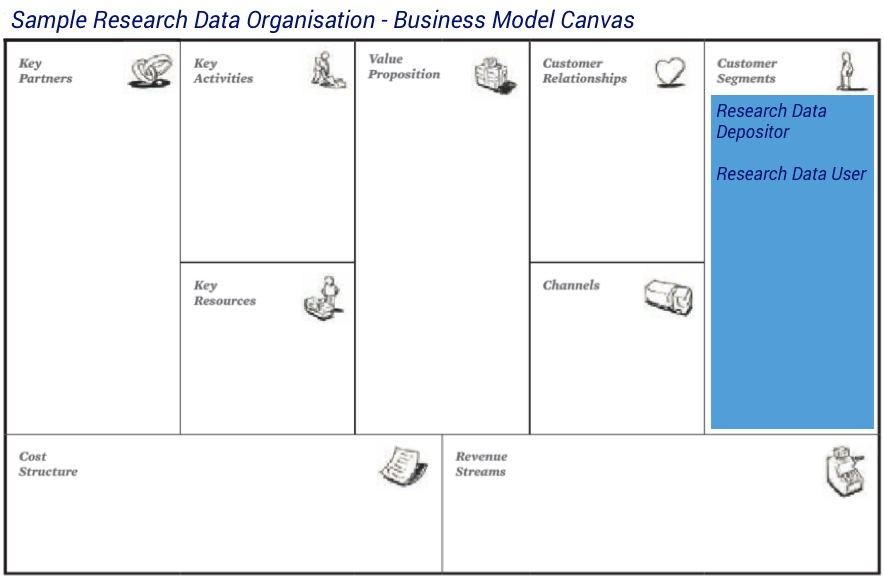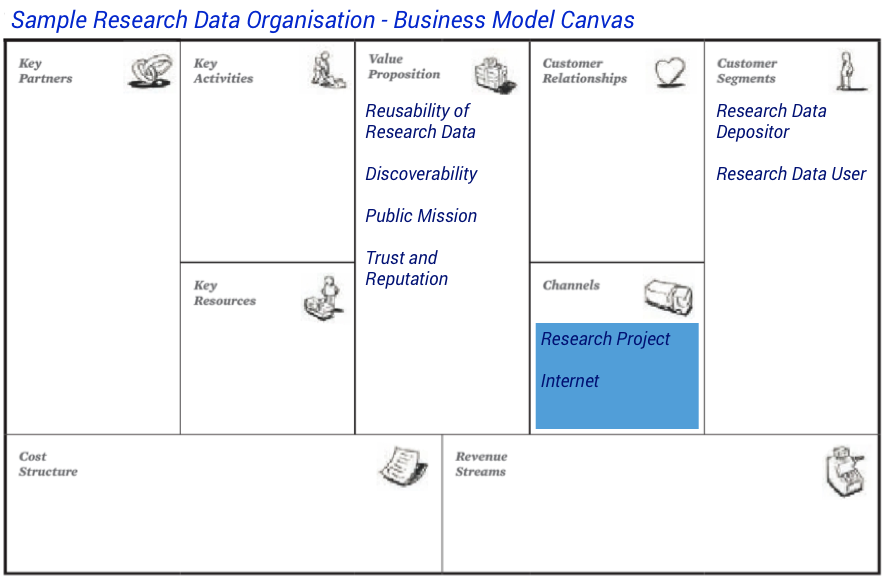Modelling an example research data organisation
Creating an example business model canvas for a typical research data organisation - let's call it RDO - is a great way to illustrate how you could apply this approach to your own organisation. In this example, we'll be using a customer-driven approach - we'll identify the customers for the services, and then work back through the value proposition to the activities, channels and infrastructure involved in delivering services to these customers. Keep in mind that other approaches, such as an activity-driven approach, could also be used.
Identify the range of customers
Start with the question - which customers use the services offered by the organisation? Group these customers by type into customer segments, and list them on the business model canvas. To separate out different customer segments, look for patterns in customer interests such as similarity in the services required by customers or the distribution channels used to deliver products to customers.
Our RDO, like many similar organisations, has two customer segments - customers who want to deposit their research data into the research data repository, and customers who want to access and use the deposited research data.
Identify the value proposition
The next question to consider is - why do these customers choose to make use of the services offered by this specific organisation? In essence, we are looking for the key reasons why customers use the specific products/service offered by this organisation over its competitors. These are the value propositions, and they form the central building block of any business model canvas. Add them to the business model canvas.
Typical value propositions for an organisation such as our RDO include increased discoverability of research data, reusability of research data, and the public mission. Data needs to be discoverable in order to be reused, so issues such as data management, support for data producers, data archiving and documentation need to be addressed. Reusability produces new opportunities for innovation and for new data users, whilst reducing the costs of duplicated research effort. Research results often originate from publicly funded projects, and research data repositories can serve the public mission in several ways. These include providing sustainable access to research data for potential future innovations, and providing source material for education and training.
Identify the distribution channels
The next question is - which channels are used to communicate to customers? Consider not only the channels through which an organisation sells/delivers its services and products, but also the channels used to promote values and raise awareness. Add these to the business model canvas.
Our RDO can provide an online Web interface to its research data repository to enable simple access for its customer segments. Cooperative agreements with project participants within research projects opens up another channel to support customers wishing to deposit research results in the repository. This would, of course, be preceded by creation of a suitable data management plan.
Identify the customer relationships
The next question is - how do customers interact with the organisation? Consider not only personal contacts where customers interact with real humans, but also automated contacts where customers are using services that do not need direct human interaction. Consider, too, interactions across the product lifespan from initial contact with new customers, through to ongoing interaction with existing customers. List these on the business model canvas.
Our RDO offers individual face-to-face contact and telephone support for research data users. Training is also provided to these users via online training material, online manuals, and presenter-delivered courses in order to promote sustainable data archiving and data reuse. Support and training is also offered to research data depositors via the same range of interactions to ensure any data being considered for deposit complies with the applicable technical, legal and descriptive (metadata) requirements.
Identify the revenue streams
Revenue streams describe the flow of payments into the organisation - these can be one-time payments or periodical payments. A successful business needs to identify for which value propositions its customers are willing to pay. Use the business model canvas to assess this by linking the revenue streams you identify to both the customers segments and the value propositions already listed on the canvas. Add this to the canvas to complete the customer perspective.
Public funding forms one revenue stream for our RDO, and this ensures that the expenses for operating and maintaining the repositories are covered. Additional fees could be charged for both data depositors and data users, and allocated for further development of the repository services catering to both customer segments.
Identify the key activities
To model the activity perspective, start with the question - what activities does the organisation need to do in order to deliver products and services to its customers? In terms of our business model, activities enable the value propositions to be delivered by putting the rest of the organisation to work. Look out for different types of activity. In production environments, activities may generate physical products; in service environments, activities may include training, consultancy and problem-solving. Add these to the business model canvas.
The key activities performed by our RDO comprise long-term preservation activities, and the coordination of infrastructure services such as policies, contracts, and service-level agreements (SLAs).
Identify the key resources
The next question is - what assets need to be in place within the organisation in order to perform these activities? Look out for different types of resource such as physical, intellectual, staff and financial assets. Example physical assets might include buildings and equipment. Example intellectual assets might include patents or partnerships. Example staff assets might include staff with specialist skills such as researchers and software developers. Example financial assets might include sufficient budget to support long-term longitudinal studies such as clinical trials.
Key staff assets required to support the activities of our RDO are the specialist skills of archivists and librarians. A key physical asset is the technical infrastructure that enables the repository to offer its services.
Identify the key partnerships
The next question is - are there any gaps in organisational capabilities that limit the ability to deliver the value proposition? Gaps, in this sense, could be a lack of resource or an inability to perform certain activities. If so, look at the potential to strike partnerships that can fill these gaps. Another possible motivation for striking partnerships is achieving economy of scale in order to reduce costs and optimise resource use. Possible impacts of these optimising partnerships include sharing infrastructure and outsourcing services.
Repositories such as our RDO can collaborate within research projects, meaning that universities and other research organisations are often key partners. Other key partners include third-party vendors who provide commercial solutions for key activities. Examples of these include outsourced services for digitisation, consulting services for repository certification, and outsourced technical infrastructure for storage. A third group of key partners are other research data repositories. These partners can share parts of the infrastructure, exchange knowledge, and provide access to a wider selection of digital assets.
Identify the cost structure
Cost structure examines how the key activities drive the costs being incurred by the organisation, and importantly whether these costs align with the value proposition. Keep in mind that costs may be fixed or may be scalable. Check out whether any major costs do align with the key activities and/or the value proposition for the organisation. List the most significant cost elements of the business model on the canvas to complete the activity perspective.
Staff/personnel costs and technical infrastructure costs are the most significant elements of cost structure for our RDO. Both of these resources are critical in driving the key activities of the organisation, and so the cost structure aligns with RDO's value proposition.
Next steps
Now you have worked through the example RDO canvas, continue with our advice on planning for sustainability.
{KomentoDisable}









